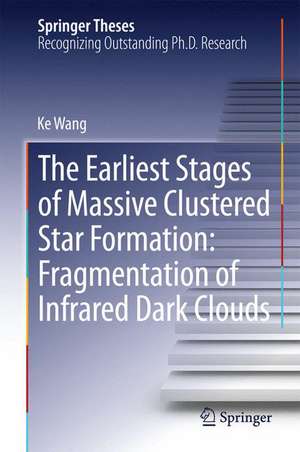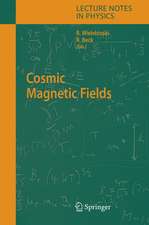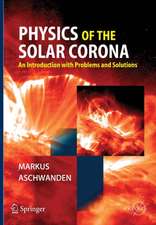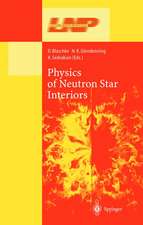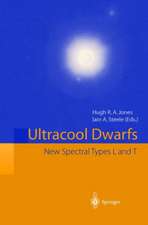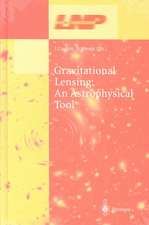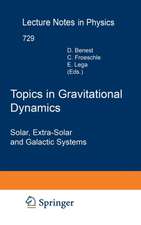The Earliest Stages of Massive Clustered Star Formation: Fragmentation of Infrared Dark Clouds: Springer Theses
Autor Ke Wangen Limba Engleză Hardback – 17 noi 2014
| Toate formatele și edițiile | Preț | Express |
|---|---|---|
| Paperback (1) | 380.84 lei 6-8 săpt. | |
| Springer Berlin, Heidelberg – 11 aug 2016 | 380.84 lei 6-8 săpt. | |
| Hardback (1) | 387.96 lei 6-8 săpt. | |
| Springer Berlin, Heidelberg – 17 noi 2014 | 387.96 lei 6-8 săpt. |
Din seria Springer Theses
- 18%
 Preț: 997.88 lei
Preț: 997.88 lei -
 Preț: 389.88 lei
Preț: 389.88 lei - 15%
 Preț: 646.94 lei
Preț: 646.94 lei - 18%
 Preț: 943.43 lei
Preț: 943.43 lei -
 Preț: 399.29 lei
Preț: 399.29 lei - 18%
 Preț: 944.99 lei
Preț: 944.99 lei - 15%
 Preț: 636.80 lei
Preț: 636.80 lei - 18%
 Preț: 941.05 lei
Preț: 941.05 lei - 15%
 Preț: 643.16 lei
Preț: 643.16 lei - 15%
 Preț: 642.68 lei
Preț: 642.68 lei - 18%
 Preț: 1103.62 lei
Preț: 1103.62 lei - 20%
 Preț: 558.82 lei
Preț: 558.82 lei - 18%
 Preț: 1112.30 lei
Preț: 1112.30 lei - 18%
 Preț: 944.19 lei
Preț: 944.19 lei - 18%
 Preț: 1109.92 lei
Preț: 1109.92 lei - 18%
 Preț: 1217.27 lei
Preț: 1217.27 lei - 15%
 Preț: 640.06 lei
Preț: 640.06 lei - 15%
 Preț: 636.45 lei
Preț: 636.45 lei - 15%
 Preț: 640.06 lei
Preț: 640.06 lei - 15%
 Preț: 640.88 lei
Preț: 640.88 lei -
 Preț: 389.70 lei
Preț: 389.70 lei - 20%
 Preț: 563.89 lei
Preț: 563.89 lei -
 Preț: 393.35 lei
Preț: 393.35 lei - 15%
 Preț: 637.93 lei
Preț: 637.93 lei - 15%
 Preț: 641.85 lei
Preț: 641.85 lei - 18%
 Preț: 1225.94 lei
Preț: 1225.94 lei - 20%
 Preț: 551.36 lei
Preț: 551.36 lei - 18%
 Preț: 1229.10 lei
Preț: 1229.10 lei - 15%
 Preț: 639.25 lei
Preț: 639.25 lei - 18%
 Preț: 999.45 lei
Preț: 999.45 lei - 15%
 Preț: 640.06 lei
Preț: 640.06 lei - 18%
 Preț: 1220.45 lei
Preț: 1220.45 lei - 18%
 Preț: 1116.26 lei
Preț: 1116.26 lei - 18%
 Preț: 1110.72 lei
Preț: 1110.72 lei - 18%
 Preț: 1000.87 lei
Preț: 1000.87 lei - 18%
 Preț: 891.17 lei
Preț: 891.17 lei - 15%
 Preț: 640.06 lei
Preț: 640.06 lei - 5%
 Preț: 1154.07 lei
Preț: 1154.07 lei - 15%
 Preț: 635.96 lei
Preț: 635.96 lei - 15%
 Preț: 640.88 lei
Preț: 640.88 lei -
 Preț: 387.20 lei
Preț: 387.20 lei - 18%
 Preț: 1109.92 lei
Preț: 1109.92 lei -
 Preț: 385.25 lei
Preț: 385.25 lei -
 Preț: 385.25 lei
Preț: 385.25 lei - 18%
 Preț: 1112.30 lei
Preț: 1112.30 lei - 18%
 Preț: 999.45 lei
Preț: 999.45 lei -
 Preț: 386.99 lei
Preț: 386.99 lei - 15%
 Preț: 637.13 lei
Preț: 637.13 lei - 20%
 Preț: 554.20 lei
Preț: 554.20 lei - 20%
 Preț: 555.57 lei
Preț: 555.57 lei
Preț: 387.96 lei
Nou
Puncte Express: 582
Preț estimativ în valută:
74.25€ • 76.70$ • 61.79£
74.25€ • 76.70$ • 61.79£
Carte tipărită la comandă
Livrare economică 25 martie-08 aprilie
Preluare comenzi: 021 569.72.76
Specificații
ISBN-13: 9783662449684
ISBN-10: 3662449684
Pagini: 176
Ilustrații: XX, 145 p. 37 illus., 23 illus. in color.
Dimensiuni: 155 x 235 x 15 mm
Greutate: 0.41 kg
Ediția:2015
Editura: Springer Berlin, Heidelberg
Colecția Springer
Seria Springer Theses
Locul publicării:Berlin, Heidelberg, Germany
ISBN-10: 3662449684
Pagini: 176
Ilustrații: XX, 145 p. 37 illus., 23 illus. in color.
Dimensiuni: 155 x 235 x 15 mm
Greutate: 0.41 kg
Ediția:2015
Editura: Springer Berlin, Heidelberg
Colecția Springer
Seria Springer Theses
Locul publicării:Berlin, Heidelberg, Germany
Public țintă
ResearchCuprins
Scientific background.- An Infrared Point Source Survey.- The “Dragon” Nebula G28.34+0.06.- The “Snake” Nebula G11.11–0.12.- The Infrared Dark Cloud G30.88+0.13.- A New Evolutionary Picture.
Notă biografică
Dr. Ke Wang is currently a research fellow at the European Southern Observatory (ESO) headquarters in Garching, Germany, with functional work at the Atacama Large Millimeter/submillimeter Array (ALMA). He received his Ph.D degree in astrophysics from Peking University in 2012. Most of his thesis work was carried out at the Harvard-Smithsonian Center for Astrophysics (CfA) in Cambridge, USA, during a pre-doctoral fellowship with duty at the Submillimeter Array (SMA). In 2011, he was awarded a European Union grant to conduct his first postdoctoral research at the Kapteyn Astronomical Institute in Groningen, the Netherlands. Afterwards, he joined ESO in October 2012. He is an enthusiastic astronomer with expertise in radio interferometers, a frequent user of world class telescopes including the SMA and the Jansky Very Large Array (JVLA), now an ALMA astronomer on duty. His main research interest is the early phase of massive star formation, from Planck cold cores, infrared dark clouds to interstellar filaments.
Textul de pe ultima copertă
This thesis presents an in-depth, high-resolution observational study on the very beginning of the formation process: the fragmentation of dense molecular clouds known as infrared dark clouds (IRDCs). Using the Submillimeter Array (SMA) and Very Large Array (VLA) radio interferometers, the author has discovered a common picture of hierarchical fragmentation that challenges some of the leading theoretical models and suggests a new, observation-driven understanding of how massive star formation in clustered environments may begin: it is initiated by the hierarchical fragmentation of a dense filament from 10 pc down to 0.01 pc, and the stellar mass buildup is simultaneously fed by hierarchical accretion at similar scales. The new scenario points out the importance of turbulence and filamentary structure, which are now receiving increasing attention and further tests from both observers and theorists.
Caracteristici
Nominated as an outstanding thesis by Peking University Presents the latest high angular resolution observational studies using the Submillimeter Array (SMA) and Very Large Array (VLA) Presents the discovery of a common hierarchical fragmentation in three infrared dark clouds Proposes a new scenario for the formation of massive star clusters Includes supplementary material: sn.pub/extras
